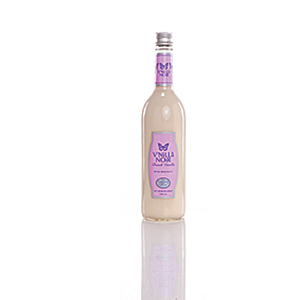A growing base for vanilla
Traditional flavor sees increased usage on- and off-premise
Beverage manufacturers have more options to choose from these days when developing flavor profiles for new products, but many are sticking to an ingredient

|
|
The number of alcohol-based products containing vanilla, such as V’Nilla Noir wine from Premium Blend Inc., has increased, according to Mintel data. |
with a long-established history — vanilla. According to Beverage Industry’s “2012 New Product Development Survey,” 44 percent of respondents reported that vanilla was among the top flavors used in 2011. Vanilla led the list of forecasted best-selling flavors for 2012, with 20 percent of respondents choosing the traditional option.
Vanilla’s use in beverages also has been seen throughout the foodservice and on-premise channels. Chicago-based Technomic Inc. reported that 16 per-cent more beverages were described as including or being flavored with vanilla in the first quarter of 2012 compared to the same time period the previous year, according to the food industry research firm’s MenuMonitor, an online menu-tracking resource for more than 1,200 top U.S. foodservice chains, emerging concepts and leading independent restaurants.
According to data from Mintel’s Global New Products Database, the number of alcohol beverage launches containing vanilla as an ingredient increased from 18 products in 2005 to 94 in 2011, says Ed McIntosh, marketing manager with Flavorchem Corp., Downers Grove, Ill. The Chicago-based market research firm also reports some usage of vanilla in wines, he adds. In the non-alcohol segment, the number of meal replacement beverages containing vanilla increased from 25 new products in 2005 to 90 in 2011, based on Mintel data, McIntosh says.
“Historically, vanilla was primarily a background flavor in beverages like colas, root beers and chocolate milk," says Rick Brownell, vice president of vanilla products for Virginia Dare, New York City. "Now, vanilla has come out of the shadows and is often featured as the characterizing flavor in beverages like vanilla soymilk, vanilla almond milk, vanilla lattes, vanilla vodkas and vanilla-flavored fortified beverages.”
Stephanie Weil, product manager of marketing with Erlanger, Ky.-based Wild Flavors, notes vanilla’s widespread popularity.
“Vanilla appeals to many demographics from kids to parents and grandparents, adding a sense of indulgence to various beverages,” she says. “It pairs well with other indulgent flavors such as chocolate and caramel and [it is] becoming more popular as a pairing to fruits and herbs adding a bit of delicacy.”
Although vanilla has long been used as a primary flavor in beverages, the ingredient also carries functional aspects for the formulation process.
“Vanilla is widely used to enhance the taste of other flavors and to help mask the taste of functional ingredients,” says Stacey Hawley, technical sales manager for Flavor Producers, Valencia, Calif.
Because of the different taste and aroma profiles that vanilla can carry, suppliers recommend that when formulating with vanilla in beverages, it is important to note which is more valuable to the finished product.
“You get a better aroma from a single-fold vanilla than you do from a five-fold, but you get more bang for your buck with the five-fold because it has five times the amount of vanillin in a given volume and generally the higher folds are less expensive,” says Phil Sprovieri, vice president of sales and marketing with Flavorchem.
Sprovieri adds that folding generally requires distillation, which causes losses of delicate top notes of pure vanilla especially as the fold strength is increased.
Vanilla also can be formulated from a number of different beans, Sprovieri says. Flavorchem offers only Madagascar beans that are bourbon processed and feature a more traditional vanilla flavor, but there also are Tahitian beans, which have a fruity character, and Indonesian beans, which have a smoky character, he says.
“All of the major industry trends in recent years seem to be highly compatible with vanilla; these include healthy, natural, clean label, organic, sustainable, etc.,” Virginia Dare's Brownell notes. “As a result, worldwide demand for vanilla has increased on average approximately 5 percent per year during this period.”
With its appeal as both a primary flavor and a masking flavor, suppliers anticipate continued growth for vanilla in beverages.
“I think we will continue to see vanilla as the featured flavor in many new beverages,” Brownell says. “Beyond that, I anticipate that we will see increasing demand for vanilla-flavored beverages in developing countries like China. Finally, I would predict that vanilla will increasingly be used in products like relaxation and energy beverages, not simply for its flavor, but for its therapeutic contribution as well.” BI
Looking for a reprint of this article?
From high-res PDFs to custom plaques, order your copy today!





